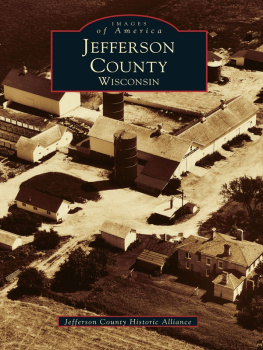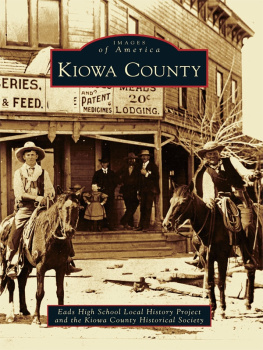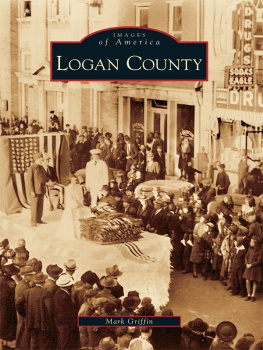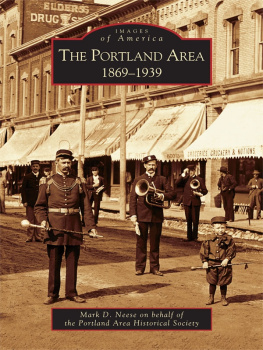
IMAGES
of America
PLOVER

Walter Barnsdale emigrated from Britain in 1885 and lived with his uncle George Barnsdale in Plover for a short time. He then worked as a lumberjack and engineer in other cities, returning to Plover in 1891. In 1896 and 1897, Walters interest in motion pictures was piqued by entertainers traveling through the area showing early motion pictures. He created improvements to the Edison machine by adding a sprocket with gears to provide for proper timing and perfecting the take-up reel, and is believed to be the first person to put the device into use. He also made his own gasoline-powered electric generator to supply power for his motion picture projector in rural areas. Barnsdale traveled the state for 20 years showing motion pictures, and after 1914, he began making his own. By 1926, larger theaters had their own machines and leased the pictures, bringing an end to Barnsdales Vivorama. (Portage County Historical Society.)
ON THE COVER: This c. 1916 photograph shows the old Plover Post Office. Plover rural mail carriers Clint Moss (left) and his son John Moss are shown with their mail carriages. In 1916, John took over his fathers route, abandoning his original Route 1. (Portage County Historical Society.)
IMAGES
of America
PLOVER
Brad Casselberry and Diane Lang

Copyright 2017 by Brad Casselberry and Diane Lang
ISBN 978-1-4671-2545-1
Ebook ISBN 9781439661222
Published by Arcadia Publishing
Charleston, South Carolina
Library of Congress Control Number: 2016958696
For all general information, please contact Arcadia Publishing:
Telephone 843-853-2070
Fax 843-853-0044
E-mail
For customer service and orders:
Toll-Free 1-888-313-2665
Visit us on the Internet at www.arcadiapublishing.com
This book is dedicated to the memory of Walter Barnsdale, without whom it would not have been possible.
CONTENTS
ACKNOWLEDGMENTS
Like any project, this book would not have been possible if it were not for the help of a variety of people. The authors would like to thank Mark Seiler for bringing this idea to us. We would also like to thank Ryan and Wayne Berrend and Gordon Fox for donating photographs and providing information for this book. Thanks also to Joyce Slack, who took the time to show us the Meehan Church and School and provided us with a sense of the Meehan community.
Thanks to the University of WisconsinStevens Point (UWSP) Nelis R. Kampenga University Archives and Area Research Center and archivist Ruth Wachter-Nelson for providing photographs and an endless supply of historical information to identify people, places, and events depicted in the photographs. The resources of the Portage County Public Library, including digital materials, pamphlet files, and staff such as Wendell Nelson were indispensable to our research.
We thank the Portage County Historical Society (PCHS) for providing the vast majority of photographs. Anton Anday and Timothy Siebert were especially helpful in clarifying details of Plovers history and providing ample stories about people, events, and buildings. PCHS has preserved a number of Plovers early buildings at Heritage Park, located at the corner of Willow Drive and Washington Avenue in Plover. Without its dedication to preserving the history of Portage County, many of these buildings would have been lost. PCHS has also preserved the glass-plate negatives of Walter Barnsdale, the source of many of the photographs in this book. He was a prolific photographer in the early 1900s in and around the village of Plover. The voluminous collection of more than 1,400 glass-plate negatives and lantern slides were sold at an estate auction and later acquired by Timothy Siebert of the Portage County Historical Society. They are invaluable in discovering the history of Plover.
Unless otherwise noted, all images appear courtesy of the Portage County Historical Society.
INTRODUCTION
There is no certainty as to why it was named Plover, but legend has it that it was named after the ringed plover, a migratory bird that once graced the shores of the Wisconsin River at Plover in large numbers. Long before the white man came to the area, what would become known as Plover was originally used by Native Americans as a staging point for portaging to the Wolf River from the Wisconsin River and as a means to bypass the rapids of the Wisconsin River. Once lumbering began along the Wisconsin River north of Plover, the area was a convenient stopping point for those traveling on the main north-south road from Portage to the pineries.
When Portage County was first divided on January 9, 1849, the county board created three townships: Plover, Middletown, and Bull Falls. Plovers borders changed again in 1850, 1852, 1859, 1869, 1870, and 1908. There are several communities within the Town of Plover that we have chosen to include in this book, including Meehan, Springville, and Whiting, the latter being incorporated as a village on November 13, 1947. Because these areas at one point existed within the borders of the Town of Plover, we felt it was appropriate to include their stories in a history of the area.
The village of Plover was the first to be platted after being chosen as the Portage County seat in 1844, likely before a community had even developed. A post office was established on January 14, 1845, called Plover Portage, as the area had been known; the name was changed to Plover on January 14, 1850. The original village plat was set east of First Street (todays Post Road), extending four blocks and stretching north from Union Street (todays Plover Road) for eight blocks and a fraction. In 1857, Plover was incorporated as Algernon, and in 1858, the name was changed to Stanton. In 1864, the village returned to Plover. The villages incorporation was dissolved around 1870 shortly after a vote on August 1, 1868, which moved the county seat from Plover to Stevens Point. This created great tensions between the two cities, and newspapers from both towns seized on the opportunity to throw accusations of cheating, underhandedness, and ineptness at one another. In 1912, the village of Plover was once again reincorporated, only to be dissolved in 1931. In 1971, the village was incorporated for a third time and has remained ever since.
In 1845, the first court was held in Plover, attracting lawyers, businessmen, and others who were drawn to the newly formed county seat, including settlers and farmers. In the early days of the village, the most important businesses were taverns and hotels. Other early businesses that were integral to the development of the community were the general stores, blacksmiths, and Plovers first newspaper, the Plover Herald, which was started in 1856 by James S. Alban and Jervis W. Carter and published by H.G. Ingersoll. In 1872, the Green Bay & Lake Pepin Railroad (later the Green Bay & Western) came to Plover, which was an east-west road, and later, the Wisconsin Central, known as the Portage Line or P-Line, was a north-south road that ran through Plover. Many prominent Portage County residents lived in Plover. Among them are Luther Hanchett, James S. Alban, Miner Strope, S.A. Sherman, Walter Barnsdale, Walt Wilmot, James Pierce, Frank Halladay, and Sheriff Joseph Baker. Other prominent residents originally settled in Plover, but after several years moved to Stevens Point for other opportunities; these included George Cate, Gilbert Park, A.E. Bourn, and John Curran.
Next page











